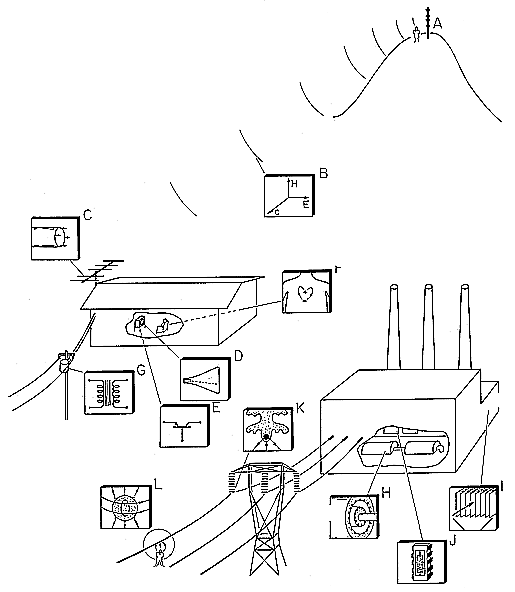Electroquasistatics is the subject of Chaps. 4-7 and magnetoquasistatics the topic of Chaps. 8-10. Before embarking on these subjects, consider in this section some practical examples that fall in each category, and some that involve the electrodynamics of Chaps. 12-14.

Our starting point is at location A at the upper right in Fig. 3.5.1. With frequencies that range from 60-400 MHz, television signals propagate from remote locations to our homes as electromagnetic waves. If the frequency is f, the field passes through one period in the time 1/f. Setting this equal to the transit time, (3.1.l7) gives an expression for the wavelength, the distance the wave travels during one cycle.

Thus, for channel 2 (60 MHz) the wavelength is about 5 m, while for channel 54 it is about 20 cm. The distance between antenna and receiver is many wavelengths, and hence the fields undergo many oscillations while traversing the space between the two. The dynamics is not quasistatic but rather intimately involves the electromagnetic wave represented by inset B and described in Sec. 3.1.
The field induces charges and currents in the antenna, and the resulting signals are conveyed to the TV set by a transmission line. At TV frequencies, the line is likely to be many wavelengths long. Hence, the fields surrounding the line are also not quasistatic. But the radial distributions of current in the elements of the antennas and in the wires of the transmission line are governed by magnetoquasistatic (MQS) laws. As suggested by inset C, the current density tends to concentrate adjacent to the conductor surfaces and this skin effect is MQS.
Inside the television set, in the transistors and picture tube that convert the signal to an image and sound, electroquasistatic (EQS) processes abound. Included are dynamic effects in the transistors (E) that result from the time required for an electron or hole to migrate a finite distance through a semiconductor. Also included are the effects of inertia as the electrons are accelerated by the electric field in the picture tube (D). On the other hand, the speaker that transduces the electrical signals into sound is most likely MQS.
Electromagnetic fields are far closer to the viewer than the television set. As is obvious to those who have had an electrocardiogram, the heart (F) is the source of a pulsating current. Are the distributions of these currents and the associated fields described by the EQS or MQS approximation? On the largest scales of the body, we will find that it is MQS.
Of course, there are many other sources of electrical currents in the body. Nerve conduction and other electrical activity in the brain occur on much smaller length scales and can involve regions of much less conductivity. These cases can be EQS.
Electrical power systems provide diverse examples as well. The step-down transformer on a pole outside the home (G) is MQS, with dynamical processes including eddy currents and hysteresis.
The energy in all these examples originates in the fuel burned in a power plant. Typically, a steam turbine drives a synchronous alternator (H). The fields within this generator of electrical power are MQS. However, most of the electronics in the control room (J) are described by the EQS approximation. In fact, much of the payoff in making computer components smaller is gained by having them remain EQS even as the bit rate is increased. The electrostatic precipitator (I), used to remove flyash from the combustion gases before they are vented from the stacks, seems to be an obvious candidate for the EQS approximation. Indeed, even though some modern precipitators use pulsed high voltage and all involve dynamic electrical discharges, they are governed by EQS laws.
The power transmission system is at high voltage and therefore might naturally be regarded as EQS. Certainly, specification of insulation performance (K) begins with EQS approximations. However, once electrical breakdown has occurred, enough current can be faulted to bring MQS considerations into play. Certainly, they are present in the operation of high-power switch gear. To be even a fraction of a wavelength at 60 Hz, a line must stretch the length of California. Thus, in so far as the power frequency fields are concerned, the system is quasistatic. But certain aspects of the power line itself are MQS, and others EQS, although when lightning strikes it is likely that neither approximation is appropriate.
Not all fields in our bodies are of physiological origin. The man standing under the power line (L) finds himself in both electric and magnetic fields. How is it that our bodies can shield themselves from the electric field while being essentially transparent to the magnetic field without having obvious effects on our hearts or nervous systems? We will find that currents are indeed induced in the body by both the electric and magnetic fields, and that this coupling is best understood in terms of the quasistatic fields. By contrast, because the wavelength of an electromagnetic wave at TV frequencies is on the order of the dimensions of the body, the currents induced in the person standing in front of the TV antenna at A are not quasistatic.
As we make our way through the topics outlined in Fig. 3.5.1, these and other physical situations will be taken up by the examples.

